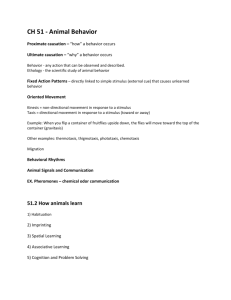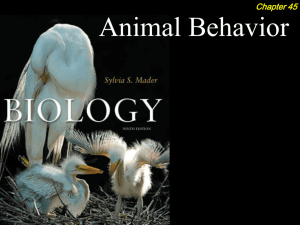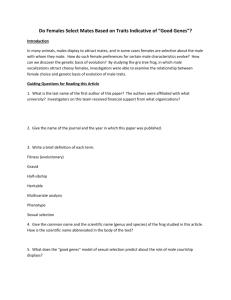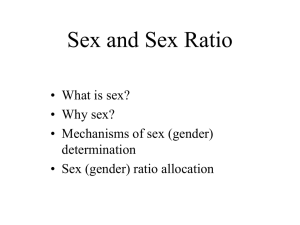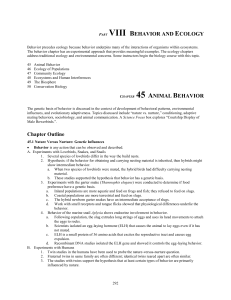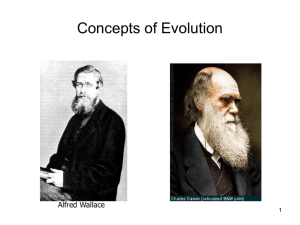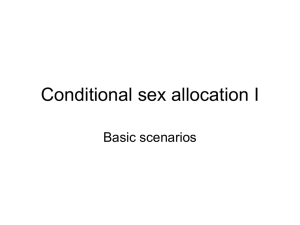B2-n32n - Newark Catholic High School
advertisement
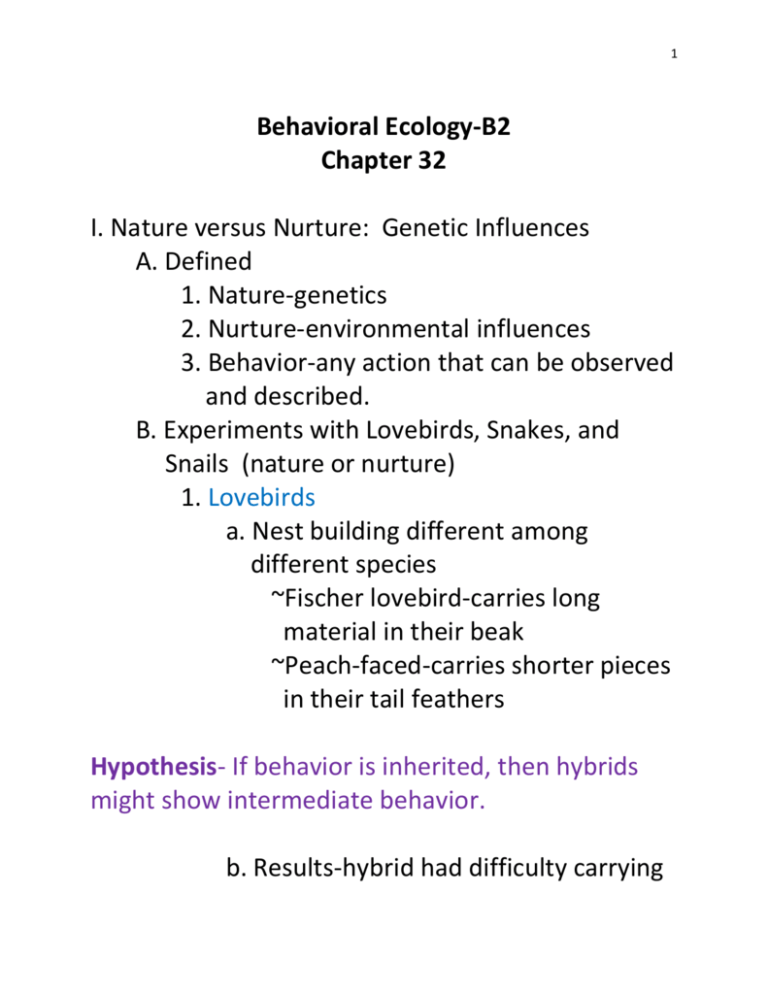
1 Behavioral Ecology-B2 Chapter 32 I. Nature versus Nurture: Genetic Influences A. Defined 1. Nature-genetics 2. Nurture-environmental influences 3. Behavior-any action that can be observed and described. B. Experiments with Lovebirds, Snakes, and Snails (nature or nurture) 1. Lovebirds a. Nest building different among different species ~Fischer lovebird-carries long material in their beak ~Peach-faced-carries shorter pieces in their tail feathers Hypothesis- If behavior is inherited, then hybrids might show intermediate behavior. b. Results-hybrid had difficulty carrying 2 nesting material c. The hybrids showed confusing behavior with a mix of both that did not show success with nest building d. Hypothesis was supported (behavior has a genetic basis) 2. Garter snakes a. Test to see if food preference has a genetic basis b. Different species will preference for different organisms. ~feed underwater on frogs/fish ~feed on land eating slugs c. Hybrids eat both d. Genetic basis for food preference ~genetics or physiology? ~tongue flicking and smell receptors are different between species. e. Nervous and Endocrine systems coordinate body systems ~are these systems involved with behavior? 3. Snails 3 a. Egg-laying behavior ~long strings of million eggs ~puts it in their mouth, swings it around to make a solid mass and then attaches it to a solid object b. Isolated the hormone that causes the snail to lay eggs. c. Hormone causes egg-laying without a male. d. Endocrine system can affect behavior C. Experiments with Humans 1. Twins a. separated at birth b. different environmental conditions 2. Results a. similar food preferences b. similar activity patterns c. picked similar looking mates Hypothesis supported that certain types of behavior are primarily influenced by nature. (genes) II. Nature versus Nurture: Environmental Influences A. Defined 4 1. FAP-Fixed action patterns a. response to a sign stimulus b. ex. Birds pecking at mother’s beak 2. Learning-a durable change in behavior brought about by experience. B. Learning in Birds 1. Introduction a. pecking behavior of newborn chicks to get their parent to regurgitate their food b. is it FAP or learned? c. Conclusion (after experimentation) was that it is both. The behavior gets better with practice 2. IMPRINTING (simple learning) a. During the sensitive period (2-3 days after hatching) the bird imprints on the first thing it sees b. interaction between chick and parent during the sensitive period is key to normal imprinting 3. SONG LEARNING (different songs and dialects from different locations) 5 a. Do birds learn to sing from their elders? TEST-3 groups 1-heard no songs ~Songs not fully developed 2-heard tapes of songs ~Sang songs from tape / same dialect 3-given adult tutor of different species ~Sang song of different species Learning and social interactions assist birds C. Associative Learning 1. Defined a. a change in behavior involving an association between two events b. ex. Learn not to eat a substance that once made you sick. (monarch) 2. Classical Conditioning a. Defined-Two different types of stimuli at the same time makes an association. 6 b. Pavlov’s Dog ~bell ~food ~saliva c. Organism can be trained (conditioned) to associate any response to any stimulus d. ex. Commercials & beautiful people e. ex. Reading to infants/toddlers 3. Operant Conditioning a. Defined ~Learning that results from reward or reinforcing a particular behavior b. B.F. Skinner ~mice ~lever ~food c. Ex. Child rearing/positive feedback III. Animal Communication A. Communicative Behavior 1. Communication 7 a. Defined-signal by a sender that influences the behavior of a receiver b. signals ~purposeful(ex. Bats going into caves) ~no purpose (ex. Moth move away from Bats radar) 2. Signal types a. chemical b. auditory c. visual d. tactile B. Chemical communication 1. Effective 24 hours a day 2. Pheromone-chemical signals in a low concentration that are passed between members of the same species. a. ex. Insects, territorial marking b. Humans? ~pheromones stimulate hormones C. Auditory Communication 1. Signals are faster than chemical signals 2. Effective 24 hours a day 3. Can be modified 8 ~pattern, duration and repetition 4. Ex. Bird Song a. distress b. courting c. territorial 5. Language is the ultimate auditory communication a. man (reason) b. primate-limited D. Visual communication 1. Used during the day a. saves energy by using intimidation b. maintains order in a community 2. Used for courtship-exact signal ~ex. P. 677 figure 32.8 fireflies 3. No need for chemical or auditory signal ~body language and positioning ~human -hairstyle -dress -gait -Do animals have emotion? P. 679 E. Tactile communication 9 1. One animals touches another animal 2. ex. Grooming, calming, young feeding 3. Ex. Bee communication (waggle dance) IV. Behaviors that affect Fitness A. Assumptions 1. Behavior is subject to natural selection (evolution) 2. Behavior has a genetic basis 3. Most behavior must have some adaptive value B. Territoriality and Fitness 1. Territoriality a. occurs mostly during reproductive times b. Costs energy to defend c. Adaptive value? ~ensures a source of food ~exclusive rights to females in area ~area to rear young ~protection from predators d. varies in size ~energy costs 10 2. Foraging for Food Animals need to ingest food that will provide more energy than the effort expended acquiring the food. a. ex. Crabs eat intermediate size clams because it takes too much energy to break open the larger clams. b. More energy = more offspring? ~trade-offs ~intelligence from predators C. Reproductive Strategies and Fitness 1. Fun facts a. Primates are polygamous -males and many females -females use more energy for Gestation and nurturing the Offspring -males can mate while one is Gestating b. A few primates are polyandrous -one female and many males -ex. New World monkey 11 -males nurture since the offspring are so large c. A few primates are monogamous -pair bonding -both help with rearing of offspring -rare in primates (18%) -occurs when males have limited mating opportunities, territoriality exists, and the male is fairly certain the offspring are his 2. Sexual Selection a. defined-a form of natural selection that favors features that increase an animal’s chances of mating b. leads to increase fitness c. Often-female choice and male competition ~females have eggs and care for their young so can be choosy d. females always know the offspring is theirs…males do not ~males produce lots of sperm ~males increase fitness if they have 12 many offspring ~intimidation calls out fitness -antlers -lion manes -auditory, etc. D. Mating in Humans A study of human mating behavior shows that the concepts of female choice and male competition apply to humans as well as to other animals. 1. Human Males Compete more men = more competition to mate a. females invest more in having a child ~gestation time ~lactation b. give sperm c. men more available to mate d. Dimorphic-males are larger and more aggressive than females ~more stress (testosterone) released more often than females ~hormones take a toll on males and 13 they usually die sooner than females (4-7 yrs) 2. Females Choose Females prefer a mate who can obtain resources(financial success) and shows symmetry in facial and body features, related to the “good genes” hypothesis (pick so young have better chance to survive) a. Study out of UT ~financial resources suggested as number one trait that females prefer. Very controversial ~increase the fitness (reproductive success) b. In the wild-females look at symmetry to determine the health of genes. ~good genes optimize success of the survival of offspring 3. Men also have a choice! a. men prefer youthfulness and attractiveness in females~provides good genes for childbearing. b. Controversial study showed 14 ~males preferred a waist to hip ratio of .7 regardless of weight ~physiologically this is the ratio optimal for conception. ~Men pick women with symmetry, high estrogen levels (fertility) and youthfulness c. smelly t-shirts (science focus p. 684) E. Societies and Fitness (genes) 1. Hypothesis ~societies form when living in a society has a greater reproductive benefit than reproductive cost. ~COST-BENEFIT analysis 2. Group living a. Benefits ~helps to avoid predators ~helps rear offspring ~helps to find food ~groom each other b. Disadvantages (costs) ~more competition ~males larger and take more energy 15 to rear than females. Females struggle ~easily spreads disease and Parasites c. Humans use health-care and medicine to offset the cost of living close to each other. F. Sociobiology and Human Culture 1. Humans live in societies since the benefits outweigh the costs. 2. CULTURE a. total pattern of human behavior b. cultural evolution surpassed biological evolution. 3. Why did human societies originate? a. hunter-gatherers. ~encouraged cooperation, communication and tools. b. if predator-prey ~evolution of intelligence? G. Altruism versus self-interest 1. Altruism defined ~self-sacrificing behavior for the good 16 of another member of the society. -benefits the recipient 2. Altruistic behavior kills the organism ~will this kill the altruistic gene? -human examples (soldier, firefighter, mother, saving other individual regardless of age) ~Animal altruism a. KIN SELECTION ~saving a close relative saves a number of the same genes b. INCLUSIVE FITNESS ~choosing the organism with the best genes (reproductive success) 3. Reciprocal altruism a. organisms help to rear offspring b. benefits may come later in life when they are rewarded with territory, food, or the survival of the young making it to maturity. 17

